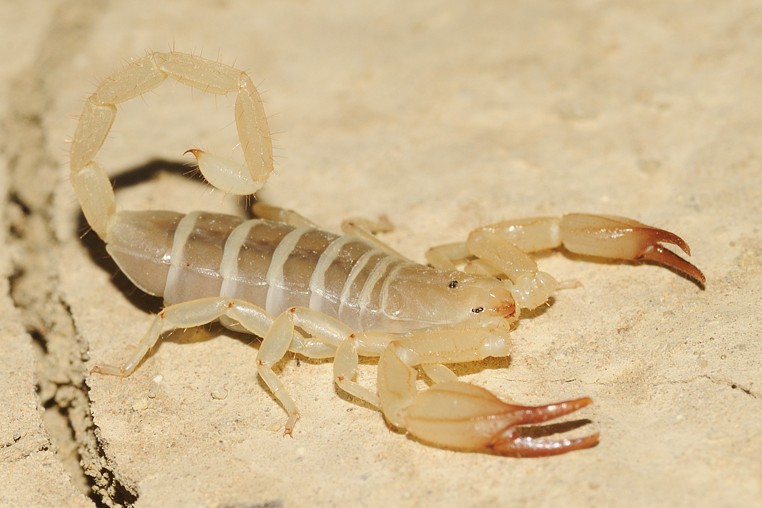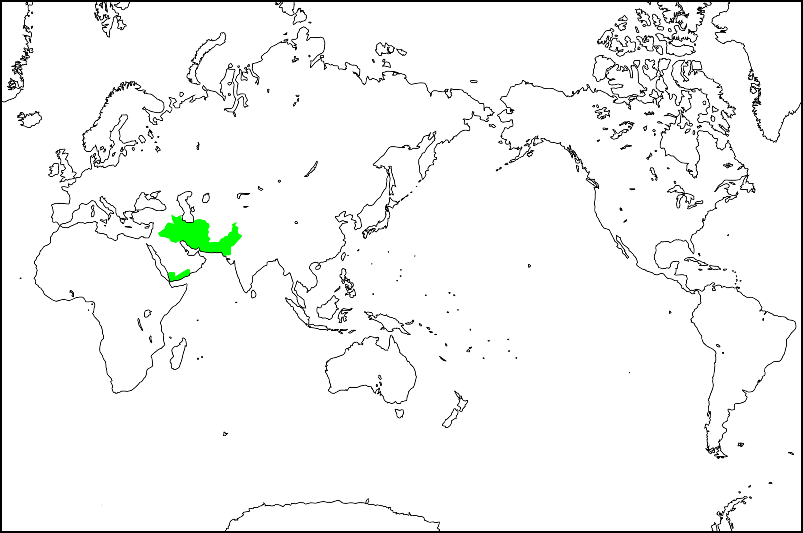Hemiscorpius lepturus
~気づかぬ間に毒が回る、細胞毒をもつサソリ~

英名:
特になし
学名:
Hemiscorpius lepturus Peters, 1861
科名:
分布:
イラン、イラク、パキスタン、イエメン (Fet et al., 2000)
体長:
オス85mm、メス50~56mm (Dehghani et al., 2007; Monod and Lourenço, 2005)

Hemiscorpius lepturusはイラン南東部によくみられるサソリで、オスはメスよりも長い終体をもっています。
飼育下では8月~9月に出産し、産仔数は15~34になります (Dehghani et al., 2007)。
通常、サソリの毒は神経毒の症状を示し、刺されるとすぐにしびれやかゆみなどを引き起こしますが、H. lepturusの毒は細胞毒の症状を強く示し、患部の皮膚が壊死して大きくただれる場合があります。また、溶血 (赤血球の破壊) や、急性腎不全を引き起こし、最悪の場合は死に至ります (Dehghani et al., 2012; Jalali et al., 2010; Pipelzadeh et al., 2007)。
他のサソリと違い、H. lepturusに刺された直後はあまり痛みを感じないそうですが、時間が経つにつれて傷口が腫れ、つづいて皮膚の壊死や臓器への障害が進んでいきます。
そのため、H. lepturusに刺されたとは気づかず、処置が遅れる場合があり、H. lepturusのLD50 (半数致死量) は5.6 mg/kgとそれほど毒は強くないものの (Jalali et al., 2010)、他のサソリの場合に比べて患者の致死率は高くなるそうです (Pipelzadeh et al., 2007)。
H. lepturusは、市街地、場合によっては家の壁の隙間や割れ目にも潜んでいることが多いらしく (Dehghani et al., 2014)、人が就寝中の夜から明け方にかけての事故が多いようです (Pipelzadeh et al., 2007)。就寝中の被害が多いことや、刺されても痛みを感じにくいことから、他のサソリに比べて深刻な被害につながっていると考えられています (Pipelzadeh et al., 2007)。
イランでは、年間約4万件のサソリ毒による被害が起き、そのうち約20件が死に至っています (Dehghani et al., 2012)。
特に、南東部のフーゼスターン州ではサソリ毒の事故が多く、そのうちの10~15%がH. lepturusによるとされていますが (Pipelzadeh et al., 2007)、死亡事故に限っては、95%がH. lepturusによるそうで (Dehghani et al., 2012)、イランでは最も危険なサソリと考えられています。
H. lepturusは、キョクトウサソリ科以外では唯一、死の危険のあるサソリといわれていましたが、Hemiscorpius属のサソリは互いによく似ていて区別が難しいため、おそらくH. lepturus以外の種による場合もあるだろうという意見もありました (Monod and Lourenço, 2005)。それを裏付けるように、2015年には同じHemiscorpiusのH. acanthocercusに右腕を刺された15歳の少年が死亡する事故が起きています (Shahi et al., 2015)。
出典 ▼
- Fet, V., WD. Sissom, G. Lowe, and ME. Braunwalder (2000) Catalog of the scorpions of the world (1758-1998), The New York Entomological Society, New York.
- Dehghani, R., T. Khamehchian and MB. Miranzadeh (2007) Surveying on the biologic behaviors of Hemiscorpius lepturus Peters 1861, scorpion in laboratory (Khuzestan, Iran) (Scorpions: Hemiscorpiidae)., Pakistan Journal of Biological Sciences, 10:3097-3102.
- Monod, L. and WR. Lourenço (2005) Hemiscorpiidae (Scorpiones) from Iran, with descriptions of two new species and notes on biogeography and phylogenetic relationships., Revue Suisse de Zoologie, 112(4):869-941.
- Dehghani, R., T. Khamehchian, B. Vazirianzadeh, H. Vatandoost and SA. Moravvej (2012) Toxic effects of scorpion, Hemiscorpius lepturus (Hemiscorpiidae) venom on mice., The Journal of Animal and Plant Sciences, 22(3):593-596.
- Jalali, A., MH. Pipelzadeh, R. Sayedian and EG. Rowan (2010) A review of epidemiological, clinical and in vitro physiological studies of envenomation by the scorpion Hemiscorpius lepturus (Hemiscorpiidae) in Iran., Toxicon, 55:173-179.
- Pipelzadeh, MH., A. Jalali, M. Taraz, R. Pourabbas and A. Zaremirakabadi (2007) An epidemiological and a clinical study on scorpionism by the Iranian scorpion Hemiscorpius lepturus., Toxicon, 50(7)984-992.
- Dehghani, R., D. Rabbani, G. Hoseindoost and M. Mashayekhi (2014) Deadly scorpion habitats of Iran., Indian Journal of Fundamental and Applied Life Sciences, 4(2):480-484.
- Shahi, M., J. Rafinejad, L. Az-Khosravi and SH. Moosavy (2015) First report of death due to Hemiscorpius acanthocercus envenomation in Iran: case report., Electronic Physician, 7(5):1234-1238.
